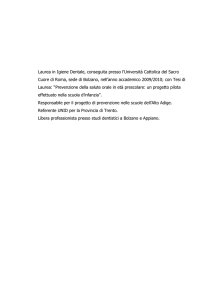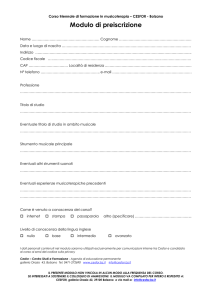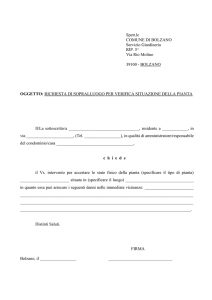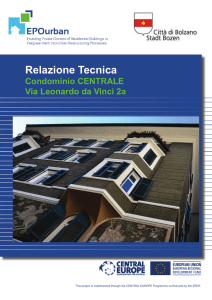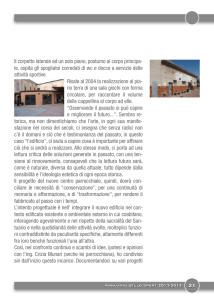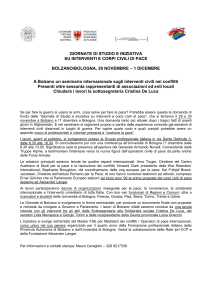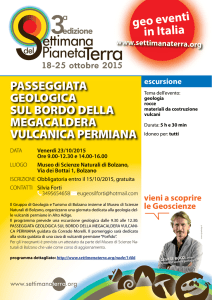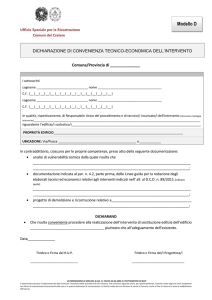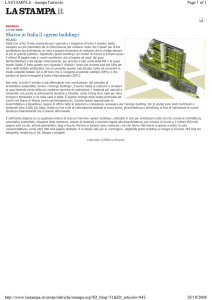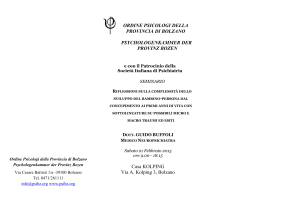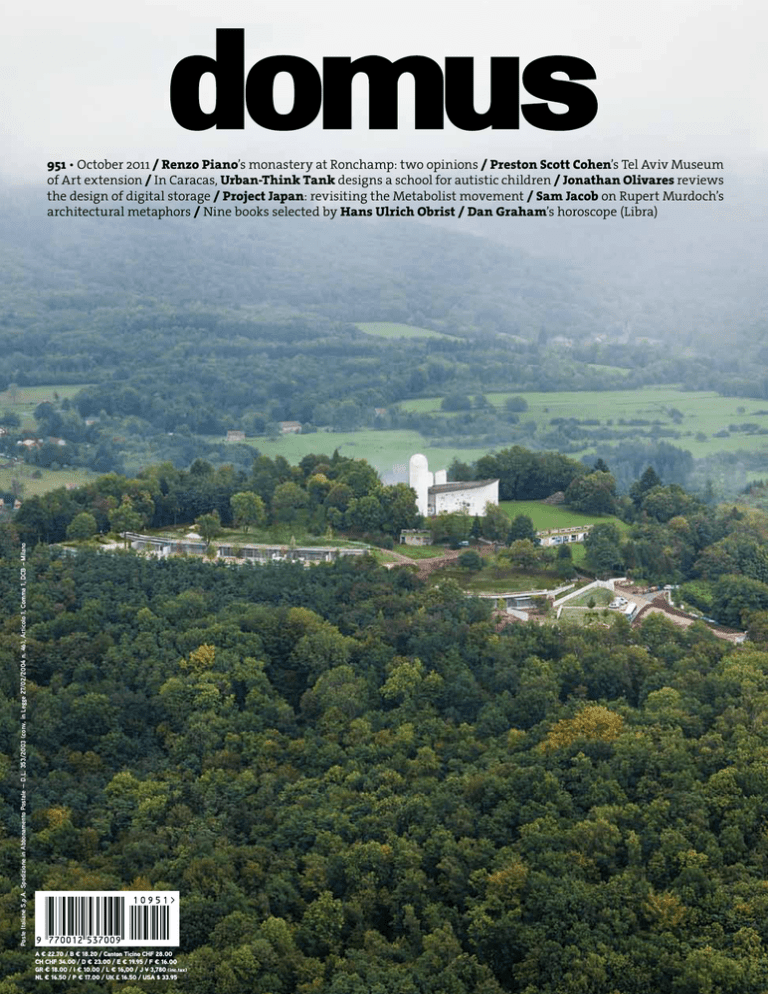
Poste Italiane S.p.A. Spedizione in Abbonamento Postale — D.L. 353/2003 (conv. in Legge 27/02/2004 n. 46), Articolo 1, Comma 1, DCB – Milano
951 • October 2011 / Renzo Piano’s monastery at Ronchamp: two opinions / Preston Scott Cohen’s Tel Aviv Museum
of Art extension / In Caracas, Urban-Think Tank designs a school for autistic children / Jonathan Olivares reviews
the design of digital storage / Project Japan: revisiting the Metabolist movement / Sam Jacob on Rupert Murdoch’s
architectural metaphors / Nine books selected by Hans Ulrich Obrist / Dan Graham’s horoscope (Libra)
A € 22.70 / B € 18.20 / Canton Ticino CHF 28.00
CH CHF 34.00 / D € 23.00 / E € 19.95 / F € 16.00
GR € 18.00 / I € 10.00 / L € 16,00 / J ¥ 3,780 (inc.tax)
NL € 16.50 / P € 17.00 / UK £ 16.50 / USA $ 33.95
domus 951
October 2011
Arrampicata
sugli specchi
A rock in a
hard place
Progetto • Design
Cino Zucchi Architetti
Park Associati
Testo • Text
Luka Skansi
Foto • Photos
Alberto Sinigaglia
•
Centro logistico e showroom, la nuova sede della
Salewa trasforma le attività legate all’alpinismo in eventi
sociali e spazi di qualificazione dell’ambiente industriale
• With a logistical centre and showroom, the new
Salewa Headquarters transforms mountaineering
and climbing sports into social events and opportunities
to improve the industrial environment
Il nuovo complesso ospita
la più grande palestra
d’arrampicata d’Italia.
Grazie al portale d’ingresso
con una parete scorrevole è
stato creato un microclima che
dà agli sportivi la sensazione di
essere all’aria aperta
• The complex houses the
largest climbing gym in Italy.
Thanks to the large entry
portal with its sliding wall, a
microclimate has been created
that gives users the sensation
of being outdoors
Bolzano
La responsabilità di un landmark
Nella nuova sede della Salewa a Bolzano si respira l’aria di
una vecchia ma ‘eroica’ Italia. Quella degli anni Cinquanta e
Sessanta, fatta di grandi e piccoli industriali e imprenditori, che
costituivano eccellenze nei propri settori economici e che intuivano
nell’architettura una potenzialità, un grande strumento per
esprimere, nel più ampio senso del termine, la propria identità
aziendale e culturale. Per non scomodare il solito, e in questo caso
forse eccessivo, esempio di Adriano Olivetti, basterebbe ricordare
le numerose iniziative edilizie di Livio Zanussi, di Vittorio Necchi,
di Giuseppe Brion, o dei gruppi Burgo e Fantoni, per rendersi conto
della qualità della committenza industriale italiana di quel periodo
e della sua diffusione sul territorio. Si trattava di committenti che
creavano le proprie sedi industriali, parallelamente a un fiorente
sviluppo aziendale, in collaborazione con i migliori architetti,
artisti, ingegneri e paesaggisti nazionali contemporanei: per loro
costruire uno stabilimento o un complesso per uffici significava
46
47
Bolzano, IT
domus 951
trasmettere, attraverso sofisticate operazioni architettoniche,
un vero e proprio modo di essere e d’intendere l’azienda e il
mercato. Per molti significava ribadire che la propria azienda era
fatta di uomini e non solo di strategie commerciali; che essa era
costruita su prodotti che esprimevano specifici concetti e valori,
e non erano solo merce che necessitava di operazioni di brand
marketing. Particolare attenzione al luogo quotidiano del lavoro
dei propri impiegati e lavoratori e a un’umanizzazione degli spazi
collettivi correva parallelamente a una sofisticata organizzazione
del lavoro, della produzione e della distribuzione. Gli stabilimenti e
gli edifici per uffici rappresentavano una sorta di completamento
quasi naturale dell’organizzazione industriale e della costruzione
dell’immagine aziendale, non etichettabile semplicemente come
temi (commerciali, funzionali, paesaggistici, tecnologici,
ecologici, spaziali e visuali) che hanno reso profondo il contenuto
stesso del messaggio.
Il complesso sorge sul bordo meridionale della zona industriale
di Bolzano, a ridosso dell’autostrada del Brennero. È il “landmark
di una provincia”, dichiara Oberrauch in un curioso video di
presentazione dell’edificio, realizzato in occasione della Biennale
di Venezia del 2010, “e io ne sento la responsabilità”. Segna infatti
fortemente la soglia tra l’autostrada, l’edificato e la densa maglia
dei frutteti e dei vigneti. Ed è qui che l’operazione si muove su
un terreno decisamente attuale, distanziandosi non tanto dai
modelli quanto dalle realtà degli illustri esempi di architettura
industriale degli anni Cinquanta e Sessanta. L’edificio mostra
operazione di rappresentazione o marketing.
Heiner Oberrauch, presidente dell’azienda Salewa ed energico
committente del nuovo complesso polifunzionale a opera di
Cino Zucchi Architetti e Park Associati, è un imprenditore di
questo stampo. L’edificio, vero landmark territoriale nel delicato
contesto della valle dell’Adige, rappresenta per diversi motivi
le specificità del suo gruppo aziendale e le sue caratteristiche di
committente: in esso si sono materializzati, grazie soprattutto
all’abilità dei progettisti e al loro reciproco confronto, il modo
d’intendere il paesaggio antropizzato, il modo d’instaurare un
rapporto con la natura, la modalità con la quale rappresentare
la sua struttura organizzativa e il senso dei suoi prodotti e, non
da ultimo, il rapporto economico e sociale da instaurare con il
proprio territorio. Architetti e committenza hanno collaborato a
creare un edificio fortemente rappresentativo, un vero marchio
architettonico. Tuttavia, si è trattato di un’operazione condotta
senza alcun tipo di volgarizzazione del messaggio commerciale;
al contrario, l’edificio è il risultato di una riflessione sui molteplici
in tutta la sua fisicità il suo atteggiamento ambientale, che non
è soltanto ecologico (l’edificio è parzialmente autonomo dal
punto di vista energetico, avendo sul tetto il più grande campo di
pannelli fotovoltaici del Trentino-Alto Adige), ma anche visivo:
non cerca mimesi nel territorio, bensì un ambientamento della
sua massa nel paesaggio della valle dell’Adige.
La fisicità e la massività vengono interpretate attraverso
due strategie: da una parte attraverso la scomposizione e la
modellazione dei diversi volumi che costituiscono il complesso,
dall’altra lavorando sulla materialità dell’involucro, sul suo
disegno e sul suo cromatismo. L’involucro è costituito da una serie
di pannelli forati in alluminio. Tre gradazioni cromatiche e tre
diversi disegni di forature costituiscono gli elementi linguistici
e grafici che permettono ai progettisti di costruire una più
complessa variazione visiva della superficie. Il dispiegamento
dei pannelli segue il disegno dei filari adiacenti, costruendo
un’analogia visiva con il pattern del territorio agricolo. Ma è a
grande scala che il gioco cromatico raggiunge il suo effetto più
48
•
Salewa Headquarters
Per rispondere al programma
multifunzionale e relazionarsi
al contesto misto, industriale
e naturale, il complesso adotta
continue variazioni di scala.
Il dinamismo che si genera
favorisce la percezione visiva
dall’autostrada
• To satisfy the multipurpose
programme and relate to
its mixed, industrial and
natural context, the complex
uses continual variations of
scale. The resulting sense of
movement enhances its visual
perception from the motorway
•
•
Le pareti vetrate continue dei
corpi degli uffici sono rivolte
a nord verso le montagne
e aprono agli ambienti di
lavoro una panoramica sul
paesaggio naturale.
La torre raggiunge l’altezza
di 47 metri
• The continuous glazed
walls of the office blocks face
north towards the mountains
and open up the workplaces
to a panoramic view of the
natural landscape. The tower
reaches a height of 47 m
Il ‘Salewa Cube’ con la
palestra d’arrampicata si
assottiglia nell’ala più bassa
vetrata che accoglie lo
showroom aziendale. Per i
climber sono a disposizione
2.000 m2 di superficie e 180
tracciati diversi. C’è anche
una via ferrata, mentre la
parete esterna Dry Tooling
permette l’allenamento con
la piccozza
• The “Salewa Cube” with its
climbing gym becomes thinner
in the lower glazed wing,
which accommodates the
company showroom. Climbers
have access to 2,000 m2 of
surface and 180 different
routes. There is also an iron
route, while the Dry Tooling
external wall enables climbers
to practise using the ice-axe
October 2011
interessante: su un principio di mimetismo d’ispirazione quasi
militare, l’involucro si comporta come una macchia in sintonia
con il territorio, inserendosi in esso attraverso l’assorbimento delle
gradazioni verde-grigio, che caratterizzano i fronti alberati delle
montagne circostanti.
Il manto del rivestimento copre i diversi volumi del complesso (i
vari ‘contenitori funzionali’), rendendo difficile la loro leggibilità
dall’esterno. Un trattamento che fa sì che l’edificio non abbia, nel
suo interno, visuali dirette verso l’esterno, ma solo filtrate dalle
bucature della pannellatura. Tuttavia, verso nord il complesso
cambia faccia: l’involucro dell’alluminio lascia spazio a una
serie di pareti interamente vetrate. Questo doppio registro,
che risponde a decisioni prevalentemente paesaggistiche (la
si relaziona non più a una scala paesaggistica, quanto urbana.
I volumi sono qui modellati con l’intenzione di costruire un
recinto fisico, nel quale ospitare una piazza. La piazza, realizzata
in collaborazione con l’artista altoatesina Margit Klammer,
leggermente sopraelevata rispetto alla strada, è il fulcro spaziale
per gli affacci di una serie di ambiti funzionali come il foyer, gli
uffici e lo showroom dell’azienda. Uno spazio urbano di qualità, che
può condizionare anche il successivo sviluppo dell’area industriale.
Ma la vera porta dell’edificio verso la città, in termini funzionali,
visivi e in fondo anche simbolici, è la grande palestra di roccia
indoor, la più grande di questo tipo realizzata in Italia. Un corpo
di altezza variabile fino a un massimo di 19 m che ha al suo
interno 1.850 m² di superficie su cui poter svolgere le vie di diverse
facciata settentrionale lucida e trasparente, gli altri affacci
sostanzialmente ciechi) è reso possibile da una complicata ma
accurata disposizione funzionale. Verso sud sono collocati i diversi
magazzini automatizzati, vero spettacolo tecnologico della Salewa.
Essi occupano la gran parte della volumetria del complesso visto
dall’autostrada e sono illuminati zenitalmente. A questo scomparto
sono addossate verso nord tutte le altre funzioni aziendali, disposte
in corpi a torre di diverse altezze: vari uffici, la direzione, un asilo
e una palestra aziendale, appartamenti per ospiti e per il custode,
una mensa si affacciano liberamente su un suggestivo panorama
della valle di Bolzano con, sullo sfondo, il potente teatro montano.
Un ampio terrazzo viene invece intagliato nella volumetria sul
fronte sud, sopra i magazzini. A ridosso delle cucine, questo spazio è
pensato come zona di ristoro o di pausa: anche questo luogo gode di
una speciale inquadratura delle montagne.
Un’ulteriore tema progettuale che gli architetti usano per definire
la forma dell’edificio è il disegno del suo affaccio verso la città, o
meglio, verso la zona industriale. Si tratta del fronte vetrato, che
difficoltà, da un livello base a un livello superiore per competizioni
agonistiche. Si tratta di un luogo già particolarmente ambito,
anche per il suo affaccio sul paesaggio, con un portale apribile in
qualsiasi momento dell’anno, anche nelle tiepide o fredde giornate
invernali o di mezza stagione, per permettere all’arrampicatore il
diretto contatto con l’esterno.
Questo edificio può, in un certo senso, essere considerato opera
unica, prodotto di un attivo e condizionante processo di selezione
operato dalla committenza che va dalla scelta del luogo (Bolzano),
agli architetti (attraverso un concorso di idee a inviti a due fasi,
che ha visto coinvolti progettisti del calibro di Perrault, Bearth
& Deplazes, Pichler, Mahlknecht & Mutschlechner, Tscholl),
ai professionisti, agli esecutori e a tutti i tecnici (attraverso
gare d’appalto) che hanno portato alla definizione finale della
complessa macchina funzionale.
—
Luka Skansi
Storico dell’architettura, iuav
49
Bolzano, IT
Salewa Headquarters
domus 951
October 2011
12
4
10
13
2
11
5
5
9
6
8
9
8
13
16
1
15
1
12
1
7
2
8
3
5
d1
d2
4
7
d2
6
d1
1
Uffici e mensa con cucina · Offices and canteen with kitchen
2 Showroom
3 Palestra d’arrampicata e area boulder
· Climbing gym and boulder area
4 Tetto verde / Sotto: magazzino meccanizzato
· Green roof / Below: mechanised warehouse
5 Terrazzo · Terrace
6 Pannelli fotovoltaici / Sotto: magazzino libero
· Photovoltaic panels / Below: free warehouse
7 Magazzino automatizzato · Automated warehouse
8 Bistro
Design Architects
Energytech Ingegneri S.r.l.
Georg Felderer
Design Team
Site Supervision
Cino Zucchi Architetti
Cino Zucchi
Park Associati
Filippo Pagliani, Michele Rossi
with Elisa Taddei (Project
architect), Alice Cuteri,
Lorenzo Merloni, Marco
Panzeri, Davide Pojaga,
Alessandro Rossi, Giada
Torchiana, Fabio Calciati
(rendering)
Structural Engineering
Kauer & Kauer Ingenieure
Georg Kauer, Ulrich Kauer
Electrical Engineering
Energytech Ingegneri S.r.l.
Gabriele Frasnelli
50
Mechanical Engineering
Cino Zucchi Architetti,
Park Associati
Plan Team GmbH
Johann Röck,
Rupert Cristofoletti
Climbing Hall Consultant
Ralf Preindl
Artistic Intervention
Margit Klammer
Contractors
ZH SpA (civil works), Stahlbau
Pichler (faCade), Walltopia,
Sintroc (climbing wall),
Zumbobel SpA, (lighting)
Client
Salewa SpA
Lamiera alluminio verniciato 30/10
10
Fissaggio puntuale · Clamping
Area totale · Site area
30,595 m2
· Painted aluminium sheet 30/10
11
Guaina impermeabilizzante con scossalina metallica
Cubatura totale · Total cubic volume
146,248 m3
2 Anima alluminio 10/10 · Aluminium core 10/10
antirumore · Waterproofing sheath with noise-
Costo · Cost
€40 million
3 Sigillatura strutturale · Structural sealing
abating metal ridge cap
Fase progettuale · Design phase
04/2007—10/2008
Costruzione · Construction
07/2009—10/2011
1
4 Serigrafia · Silkscreening
12
Parete prefabbricata a secco · Prefabricated dry wall
5 Forex 5 mm · Forex 5 mm
13
Sistema isolato di aggancio della sottostruttura in
6 Sigillatura · Sealing
acciaio zincato · Insulated clamp system for the
7 Parete a secco · Dry wall
8 Lamiera acciaio zincato 8/10 · Galvanised steel plate 8/10
galvanised steel substructure
14
9 Lamiera in alluminio 30/10 mm elettrocolorata forata,
Sottostruttura in alluminio elettrozincato
· Substructure in electro-galvanised aluminium
ø30 ø50 ø70 mm · Aluminium sheet 30/10 mm thick
15
Piastra metallica · Metal slab
electrocoloured, ø30 ø50 ø70 mm
16
Solaio in cemento armato a vista
· Floor slab in unfaced reinforced concrete
pianta delle coperture
roof plan
0
10m
B1
B2
A
C
dettagli
details
sezione a—a’
section a—a’
0
0
5cm
5m
51
Salewa Headquarters
Bolzano, IT
The new Salewa Headquarters in Bolzano exudes the air of
an old but “heroic” Italy: that of the 1950s and ’60s, created by
major and minor industrialists and entrepreneurs who brought
excellence into their economic sectors. It was they who intuited
that architecture could be a potential, a great vehicle through
which to express, in the widest sense of the term, their corporate
and cultural identities. Leaving aside the usual, and in this case
perhaps excessive, example of Adriano Olivetti, one need only
recall the numerous building initiatives undertaken by Livio
Zanussi, Vittorio Necchi, Giuseppe Brion, or by the Burgo and
Fantoni groups, to appreciate the quality of Italian industrial
elaborate organisation of work, production and distribution.
Their factories and office buildings represented an almost natural
completion of their industrial organisation and of the building
of a corporate image, not just labelled as a representation or
marketing operation.
Heiner Oberrauch, CEO of the Salewa corporation and energetic
client of the new multifunctional complex designed by Cino
Zucchi Architects and Park Associati, is an entrepreneur of that
ilk. The building, truly a landmark within the delicate context
of the Adige valley, represents, for diverse reasons and themes,
the peculiarities of his corporate group and its characteristics
as a client. In it are materialised, thanks above all to the ability
of the architects and to their mutual comparison, the approach
•
Responsibility for a landmark
domus 951
clients of that period and of their widespread effect. These were
clients who created their own industrial headquarters, parallel to
a flourishing corporate growth and in collaboration with the best
contemporary Italian architects, artists, engineers and landscape
designers. For them, building a factory or an office complex meant
transmitting, through sophisticated architectural operations,
an authentic way of being, of understanding a company and
its market. For many it meant stating that their company was
made up of people and not only of sales strategies; that it was
built on products expressing specific concepts and values, and
not simply on goods to be brand marketed. Particular attention
to the everyday workplace of their staff and workers, and the
humanisation of collective corporate spaces went with an
to the anthropised landscape, the manner of establishing a
rapport with nature, the procedure with which to represent
its organisational structure and the sense of its products;
and, not least, the economic and social relationship to be
established with its surroundings. The architects and the client
joined forces to create a distinctly representative building, a
genuine architectural trademark. This, however, has been an
operation conducted without the slightest vulgarisation of the
commercial message. On the contrary, the building is the result
of a reflection on the many different themes—commercial,
functional, landscape design, technological, ecological, spatial
and visual—that have made the actual contents of that message
complex and profound.
•
•
La geometria spezzata
dell’involucro metallico crea
assonanza con l’orografia
circostante. La pelle
dell’edificio è realizzata con
pannelli di alluminio forato
ed elettrocolorato
• The broken geometry
of the outer metal frame
creates an assonance with
the configuration of the
surrounding mountains.
The building’s skin is
built with perforated and
electrocoloured aluminium
panels
In alto: una parte della copertura
è un giardino pensile, con una
zona verde, una terrazza e un
camminamento in legno.
Sotto: il magazzino
automatizzato, con struttura
prefabbricata e microshed
• Above: part of the roof is a
hanging garden, with a green
zone, a terrace and a wooden
walkway. Below: the automated
warehouse, built with a
prefabricated structure, has
microshed skylights
52
October 2011
The complex is situated on the south edge of Bolzano’s
industrial zone, next to the Brennero motorway. It is the
“landmark of a province”, states Oberrauch in a curious
video presentation of the building made in concomitance
with the 2010 Venice Biennale, “and I feel responsibility
for it”. It strongly marks in fact the threshold between
the motorway, the built area and the dense fabric of
orchards and vineyards. It is here that the operation
moves on a decidedly topical ground, keeping its distance
not so much from the models as from the reality of the
illustrious examples of industrial architecture of the ’50s
and ’60s. The building in all its physicality displays its
environmental attitude. This is not only ecological (the
Sulla copertura di uno dei
magazzini sono disposti 1.666
moduli fotovoltaici Sunpower
BLK, per una superficie
totale di 2.073 m2. La stima
dell’energia che sarà prodotta
in un anno è di 400.000 kWh
• Set on the roof of one of
the warehouses are 1,666
Sunpower BLK photovoltaic
modules, occupying a total
surface of 2,073 m2. An
estimated 400,000 kWh will
be produced each year
building is partially self-sufficient in terms of energy,
with the largest stretch of photovoltaic panels on its roof
to be seen anywhere in Trentino Alto Adige), but visual
too. It does not attempt to disguise itself but rather to
relate its mass to the landscape of the Adige valley.
The physicality and massiveness are interpreted with
two strategies. On the one hand through the breakingdown and modelling of the different volumes of which
the complex is composed, and on the other by working
on the materiality of its cladding, design and colour.
The cladding consists of perforated aluminium panels.
Three shades of colour and three different patterns of
perforation comprise the linguistic and graphic elements
that have allowed the architects to construct a more
complex variation of the surface. The arrangement of
panels follows the pattern of adjacent rows of trees, thus
constructing a visual analogy with that of its agricultural
context. But it is on a large scale that the play of colour
attains its most interesting effect: on a camouflage
principle of almost military inspiration, the outer frame
behaves like a stain in harmony with its surroundings,
merging into it through the absorption of grey-green
shades from the woods on the surrounding mountains.
The cladding of the complex’s various volumes—the
various “functional containers”—makes their legibility
difficult from the outside. As a result of this treatment the
building has no direct views of the exterior from within,
but only those filtered by the holes in the panelling.
However, to the north the building changes face. The outer
aluminium front leaves room for entirely glazed walls.
And this dual feature, arising from mainly landscape
decisions—the shiny and transparent north front, and
the other sides mostly blind— is made possible by a
complicated but effective functional arrangement. Located
to the south are the various automated warehouses, truly a
technological marvel staged by Salewa. These occupy most
of the complex’s volumetry seen from the motorway and
are lit from above. Next to this department to the north
are all the other corporate functions, set in tower units of
different heights.
Housing various offices, management, a nursery and a
company gymnasium, guest and janitor accommodation
and a canteen, they look freely over a delightful panorama
of the Bolzano valley with its impressive mountain scenery
in the background. An extensive terrace is cut into the
volumetry of the south front, above the warehouses. Next
to the kitchens, this space is seen as a refreshment or rest
zone. And this place too enjoys a special picture view of the
mountains.
A further theme used by the architects to define the
building’s form is the design of its city front, namely that
facing the industrial zone. This is the glazed front, relating
no longer to a landscaped but rather to an urban scale. The
volumes here are modelled with the intention of building
a physical enclosure, in which to contain a plaza. The plaza,
created in collaboration with the South Tyrolean artist
Margit Klammer and slightly raised above the street, is the
spatial fulcrum for the fronts of functional areas such as
the company’s foyer, offices and showroom. As a quality
urban space, one hopes that it may favourably condition
the subsequent development of the industrial area.
But the building’s real gateway to the city, in functional,
visual and basically also symbolic terms, is the large indoor
rock-climbing gymnasium, the largest of its kind in Italy.
A block of variable heights to a maximum 19 metres, it has
an interior surface of 1,850 square metres on which ascents
of varying difficulties can be experienced, from a basic
level to that of expert sports competitions. This is already
a particularly popular place, due also to its views of the
landscape, with a front that can be opened at any time of
the year, even in tepid or cold winter or spring days, to give
climbers a direct contact with the exterior.
This building can, in a sense, be considered a unique work,
resulting from an active and conditioning process of
selection by the client, extending from the choice of place
(Bolzano) to the architects (through a two-phase ideas
competition by invitation, involving architects of the
calibre of Perrault, Bearth & Deplazes, Pichler, Mahlknecht
& Mutschlechner, Tscholl), and to the professionals,
managers and all the technicians (through bids for tender)
that led to the final definition of the complex functional
machine.
—
Luka Skansi
Architecture historian, iuav
53

